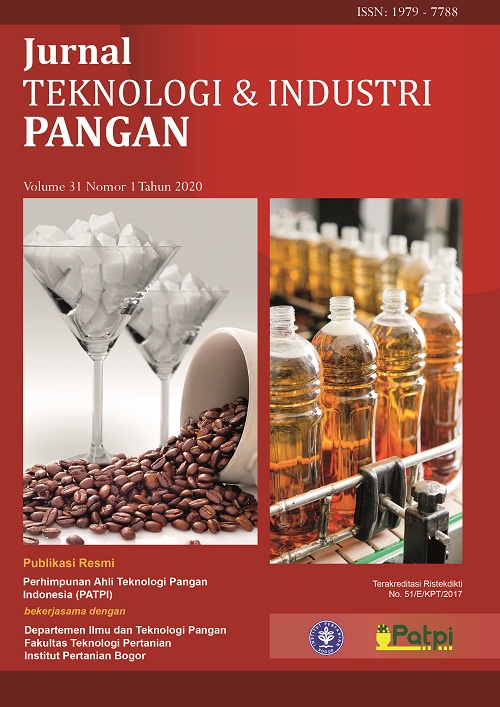CARBOHYDRATE DEGRADATION OF TUBER PASTE FLOUR BY THE ADDITION OF α-AMYLASE FROM TWO Lactobacillus SPECIES
Abstract
The quality of Indonesia tuber flour can be improved by α-amylases which hydrolyzes the flour amylose to glucose and maltose. These monosaccharides causes the flour to have better homogeniety similar to wheat flour and easier to digest. This research aimed at investigating carbohydrate degradation of tuber paste flour by the addition of α-amylase from two Lactobacillus species. Lactobacillus species used were Lactobacillus bulgaricus and L. plantarum B110, while the flour types were made of local taro (Colocasia esculenta), gadung (Dioscorea hispida) and sweet potato (Ipomoea batatas), as well as wheat (Triticum) as a reference. Crude α-amylase activity and reducing sugars were detected by the Dinitrosalycylic acid (DNS) method. Data were statistically analyzed with ANOVA. Research results indicated that α-amylase from L. bulgaricus and L. plantarum B110 have been characterized for their optimum activity and stabilitiy. The reducing sugar content in taro, gadung, sweet potato paste flour and wheat paste flour added with α-amylase of L. bulgaricus increased by 0.008, 0.006, 0.004 and 0.001%, respectively. Meanwhile, the reducing sugars of the above flours added with amylase from L. plantarum B110, increased by 0.008, 0.008, 0.008, and 0.003%, respectively. Increase in reducing sugar contents in carbohydrate degradation of local tuber paste flour added with L. bulgaricus α-amylases was higher than that in wheat paste flour with a 0.001% increase. Similarly, the 0.008% increase of sugar content in tuber paste added with L. plantarum B110 α-amylase was also higher than that in wheat flour with 0.003% increase. Therefore, local tuber paste flour can be used as an alternative to wheat paste flour.
References
do Esperito-Santo AP, Mouquet-Rivier C, Humblot C, Cazevieille C, Icard Vemiere C, Socrol CR, Guyot GP. 2014. Influence of cofermentation by amylolytic Lactobacillus strains and probiotic bacteria on the fermentation process, viscosity and microstructure of gruels made of rice, soy milk and passion fruit fiber. Food Res Int 57: 104-113. DOI: 10.1016/j.foodres.2014.01.028.
Fossi BT, Tavea F, Fontem LA, Ndjouenkeu R, Wanji S. 2014. Microbial interactions for enhan-cement of a-amylase production by Bacillus amyloliquefaciens 04BBA15 and Lactobacillus fermentum 04BBA19. Biotechnol Reports 4: 99-106. DOI: 10.1016/j.btre.2014.09.004.
Kanpiengjai A, Lumyong S, Nguyen HT, Haltrich D. 2015. Characterization of a maltose-forming α-amylase from an amylolytic lactid acid bacte-rium Lactobacillus plantarum S21. J Mol Catal B: Enzymatic 120: 1-8. DOI: 10.1016/j.molcatb. 2015.06.010.
Miller GL. 1959. Use of dinitrosalicylic acid reagent for determination of reducing sugar. Anal Chem 31: 426-428. DOI: 10.1021/ac60147a030.
Moradi M, Shariati P, Tabandeh F, Yakhcali B, Kha-niki GB. 2014 Screening and isolation of power-ful amylolytic bacterial strains. Int J Curr Micro-biol Appl Sci 3: 758-768.
Santoyo MC, Loiseau G, Sanoja RR, Guyot JP. 2003. Study of starch fermentation at low pH by Lactobacillus fermentum Ogi E1 reveals un-coupling between growth and α-amylase pro-duction at pH 4.0. Int J Food Microbiol 80: 77-87. DOI: 10.1016/S0168-1605(02)00140-X.
Savitri, Bhalla TC. 2013. Characterization of bhatoo-ru, a traditional fermented food of himachal pra-desh: Microbiological and biochemical aspects 3 Biotech 3: 247-254. DOI: 10.1007/s13205-012-0092-2.
Sharma A, Satyanarayana T. 2013 Microbial acid-stable-amylases: Characteristics, genetic engi-neering and applications - a review. Proc Bio-chem 48: 201-211. DOI: 10.1016/j.procbio.201 2.12.018.
Singh K, Srivastava G, Talat M, Srivastava ON, Ka-yastha AM. 2015. α-Amylase immobilization onto functionalized graphenenano sheets as scaffolds: Its characterization, kinetics and po-tential applications in starch based industries.
Biochem Biophys Reports 3: 18-25. DOI: 10.1016/j.bbrep.2015.07.002.
Songré-Ouattara LT, Mouquet-Rivier C, Icard-Ve-rnière C, Rochette I, Diawara B, Guyot JP. 2009. Potential of amylolytic lactic acid bacteria to replace the use of malt for partial starch hyd-rolysis to produce African fermented pearl millet gruel fortified with groundnut. Int J Food Micro-biol 130: 258-264. DOI: 10.1016/j.ijfoodmicro.20 09.02.002.
Tallapragada P, Rayavarapu B, Rao P.P, Ranga-nath NN, Veerabhadrappa PP. 2018. Screening of potential probiotic lactic acid bacteria and production of amylase and its partial purifica-tion. J Genetic Engineering Biotechnol 16: 357-362. DOI: 10.1016/j.jgeb.2018.03.005.
Wang J, Li J, Lu F. 2018. Molecular cloning and biochemical characterization of an α-amylase family from Aspergillus niger. Electronic J Bio-technol 32: 56-62. DOI: 10.1016/j.ejbt.2018.01. 004.

